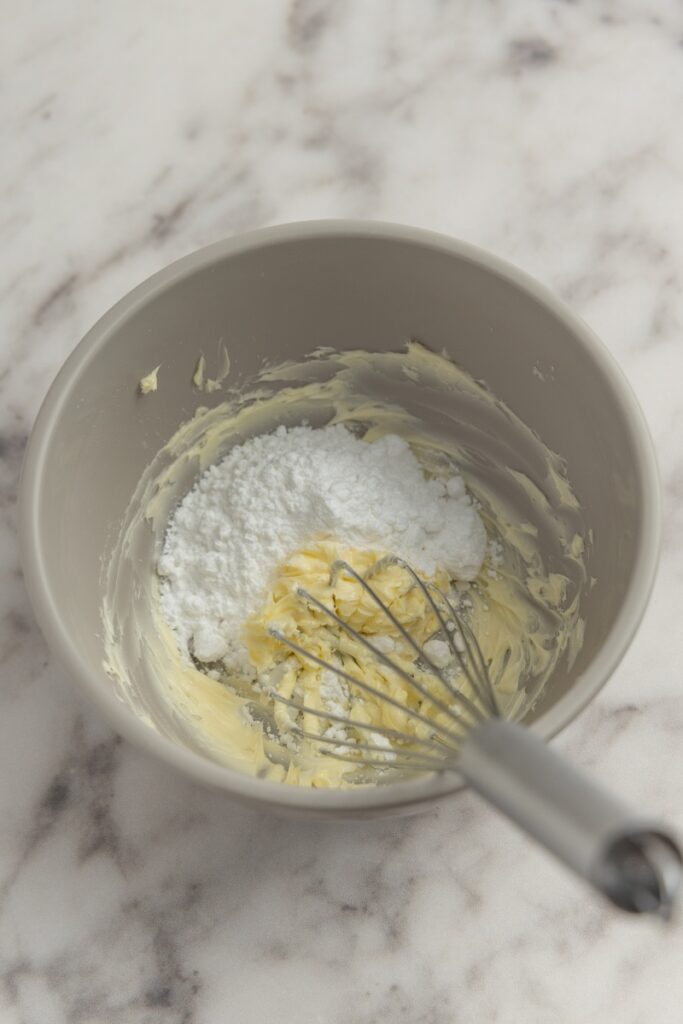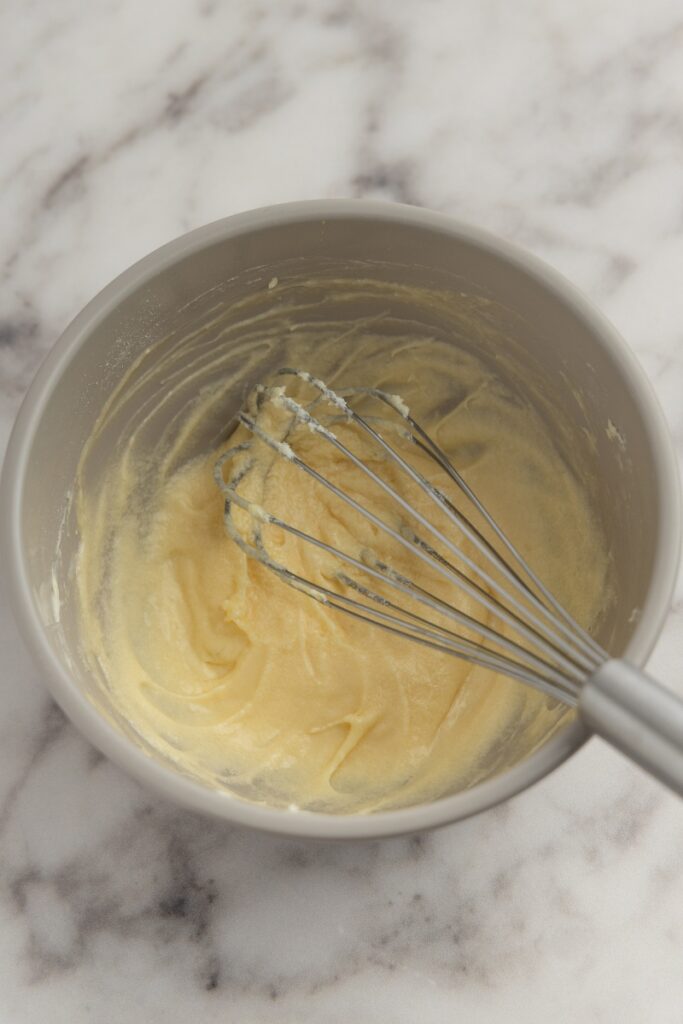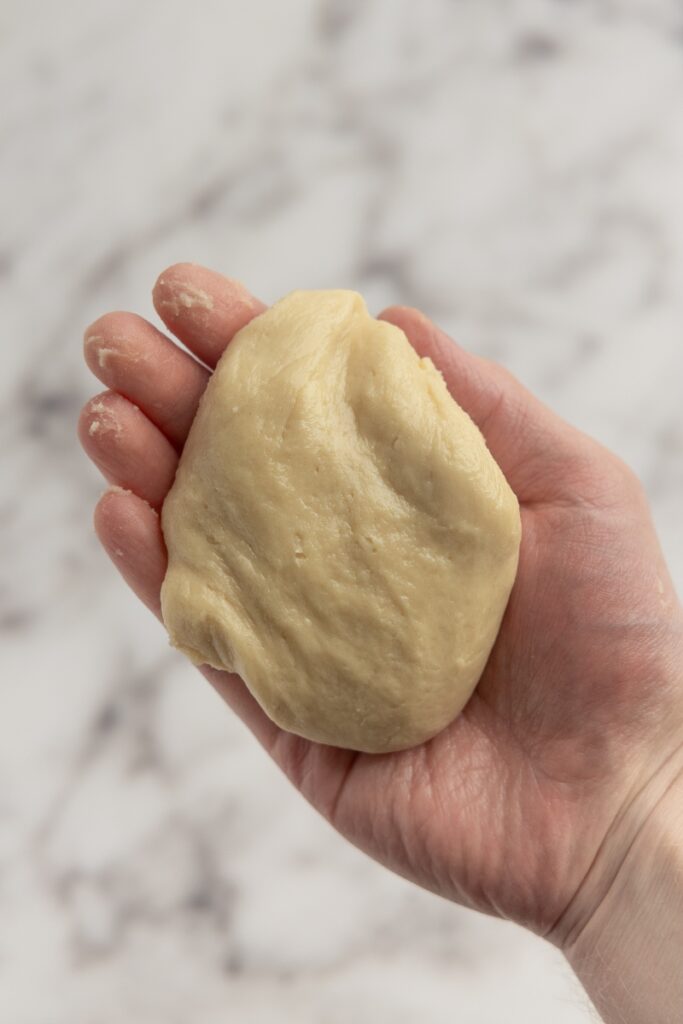Sweet Tart Dough for Your Tart Shells (Pâte Sucrée)
This post may contain affiliate links. Read our privacy policy.
Pâte sucrée is one of the foundational doughs in French baking. It’s a versatile and easy-to-make pastry that’s perfect for creating a variety of tarts and tartelettes with a tender, buttery crust.
In this article, we’ll use a simple pâte sucrée recipe that uses only pantry staples, so no almond flour needed.
Below you’ll find:
- step-by-step instructions on how to make the dough
- steps for rolling it out and lining your pie dish or tart ring
- baking instructions
- ingredient proportions for different pan (or ring) sizes
Let’s jump right in.

Recipe At a Glance
Pâte sucrée is an easy and versatile dough for your tarts and tartelettes. This basic version uses only pantry staples, so you don’t need to buy almond flour just to bake the tart shell.
That said, making the shell takes a bit of time. You’ll need to chill the dough for about 2 hours before rolling it out, freeze it for 20 minutes before baking, and you might need to pop it back into the freezer once or twice more while forming.
Below, I show you two ways to bake the tart shell: using a tart ring and a perforated mat, or using a regular pie dish. So no matter what your setup is, I’ve got you covered.
Finally, make sure to read the step-by-step instructions and tips before making the tart shell for the first time. The process is simple, but there are a few key points to remember to get it right without frustration.
Ingredients Notes and Substitutes

- Unsalted butter. European-style butter is the best option, but regular unsalted butter works okay too.
- Powdered sugar. Powdered (or icing) sugar melts easily into the butter without much mixing, making it by far the easiest option to work with. Superfine sugar is an alternative, but you’ll need to mix the sugar with the butter longer for it to dissolve. Regular granulated sugar can also work, but you’ll need much more time to mix it in, or you’ll end up with a grainier texture. When substituting, substitute by weight, not volume.
- Egg. The egg is our binding agent. After cracking, make sure to lightly beat the egg, then measure out the amount needed. You can use the leftover egg for your next scramble.
- Salt. Table or sea salt is all you need.
- All-purpose flour.
How to Make Pâte Sucrée
- Cream the butter. In a bowl, mix the butter and sugar until light and fluffy using a whisk or hand mixer. If you’re using superfine or granulated sugar, mix until the sugar granules are no longer noticeable when you rub a bit of the mixture between your fingers.
 Whisk the butter
Whisk the butter and sugar until
and sugar until light and fluffy
light and fluffy
- Add egg and salt. Use a scale to measure the exact amount of egg needed, then add it along with the salt. Mix to combine.
 Mix in the
Mix in the egg and salt
egg and salt
- Stir in flour. Add the flour and mix thoroughly with a spatula or whisk until the mixture resembles coarse crumbs and starts coming together. Then, bring the dough together using your hands, pressing it into a cohesive mass and incorporating all crumbs. Squeeze the dough a couple of times to ensure everything is combined and there aren’t any dry spots, but avoid kneading.
 Add the flour into the mixture
Add the flour into the mixture Whisk until it comes together
Whisk until it comes together Press dough into a mass
Press dough into a mass
- Make a disc and wrap. Flatten the dough into a disc and wrap it with plastic wrap or place it in a resealable bag. A flat disc will chill faster than a ball.
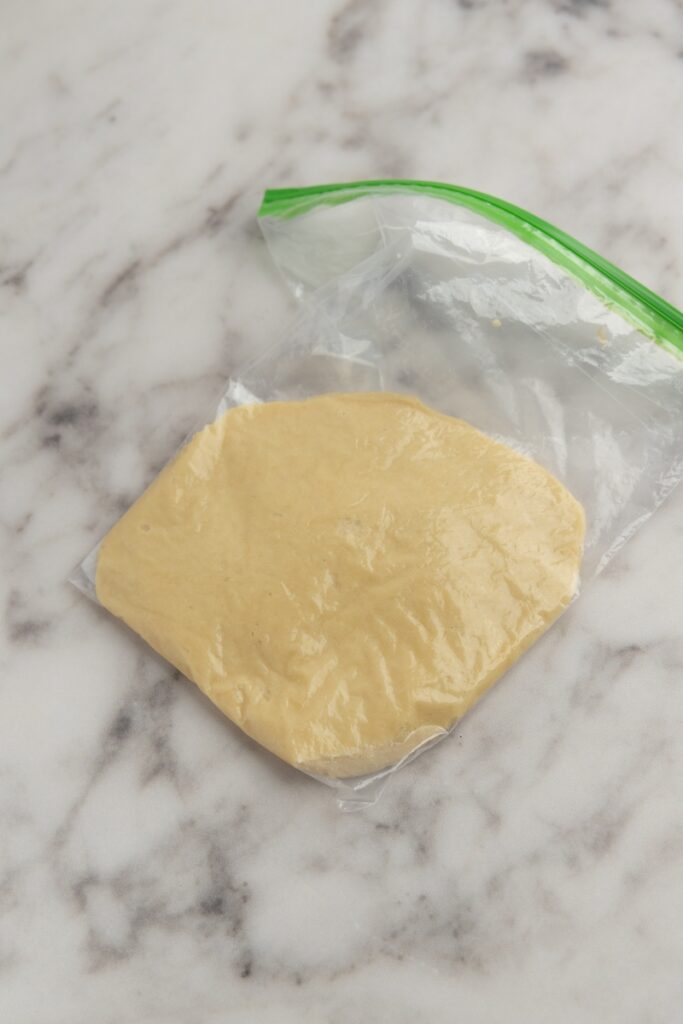
- Refrigerate. Place the dough in the fridge for 2 hours to make it easier to roll out and to ensure a tender texture. Don’t skip this step.
Once the dough has chilled for two hours, it’s time to roll it out and line your pie dish or tart ring. Let’s start with a traditional pie dish setup.
How to Line a Pie Dish
- Roll out. Roll the dough between two pieces of parchment paper to an even thickness of 1/8 inch. Make sure it’s large enough to cover the base and sides of the pie dish with a bit extra. Trim any excess if there’s too much.
 Roll dough to 1/8-inch
Roll dough to 1/8-inch check size for the pie
check size for the pie dish, and trim excess
dish, and trim excess
- Pierce the dough. Remove one piece of parchment and pierce the dough all over with a fork to allow steam to escape during baking. The pierced side will face down in the dish.

- Freeze. Replace the parchment on top and freeze the dough for about 20 minutes until it’s solid. This helps with transferring it without tearing.
- Butter the pie dish. Butter the base and sides of the pie dish. A small knob of butter spread with your fingers works well.

- Transfer dough. Remove the top parchment, place the dough over the pie dish with the pierced side down, then remove the remaining parchment. Center the dough over the dish, then gently warm it with your hands to soften it, allowing it to mold to the dish’s shape. Start softening from the center and move outwards, making only a bit of progress at a time, so you don’t stretch the dough. Once it’s in place, smooth out any creases or folds, ensuring it adheres to the sides. Don’t trim the excess just yet.
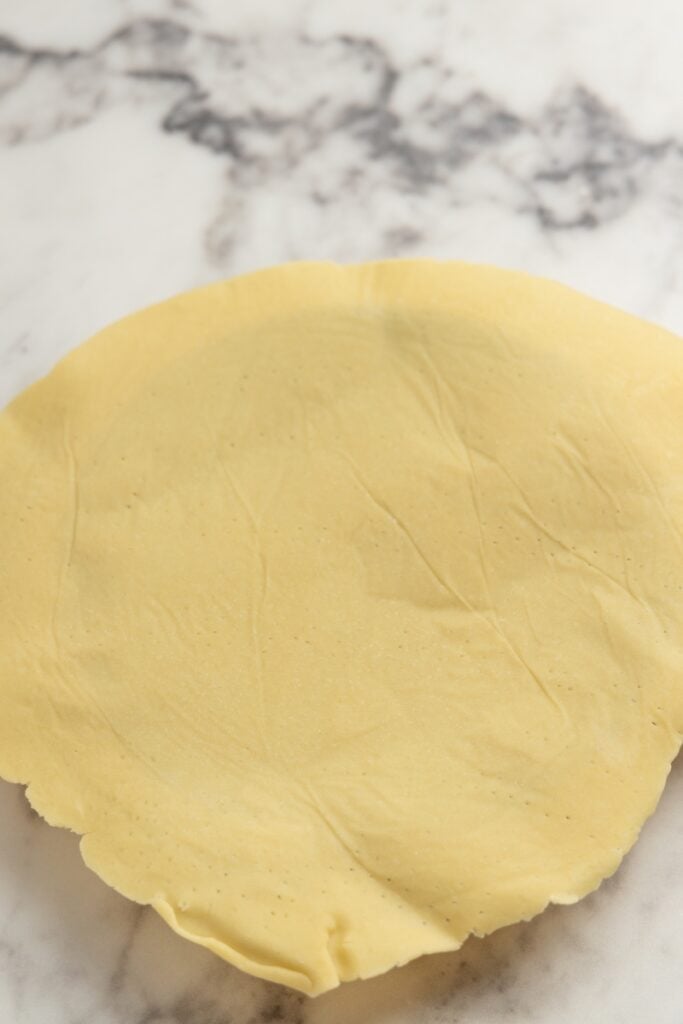



- Freeze. Place the pie dish with the dough in the freezer for about 20 minutes. If it needs to stay longer, cover it.
- Preheat oven. While the dish is in the freezer, preheat your oven to 360°F (180°C).
- Trim excess. Once the dough is chilled and the oven is preheated, remove the pie dish and trim the excess dough. Place a knife inside the dish and cut outward to ensure the dough adheres to the dish’s side.

- Bake. Place the pie dish in the oven and immediately lower the temperature to 340°F (170°C). Bake for 13 to 16 minutes, until the shell is lightly browned. The color is more important than the baking time, so it’s okay if it takes a couple of extra minutes. If any large bubbles form, gently tap them with the back of a spoon a couple of times. They won’t collapse immediately, but they likely will at least shrink within a minute or so. Be careful, as the oven is hot.
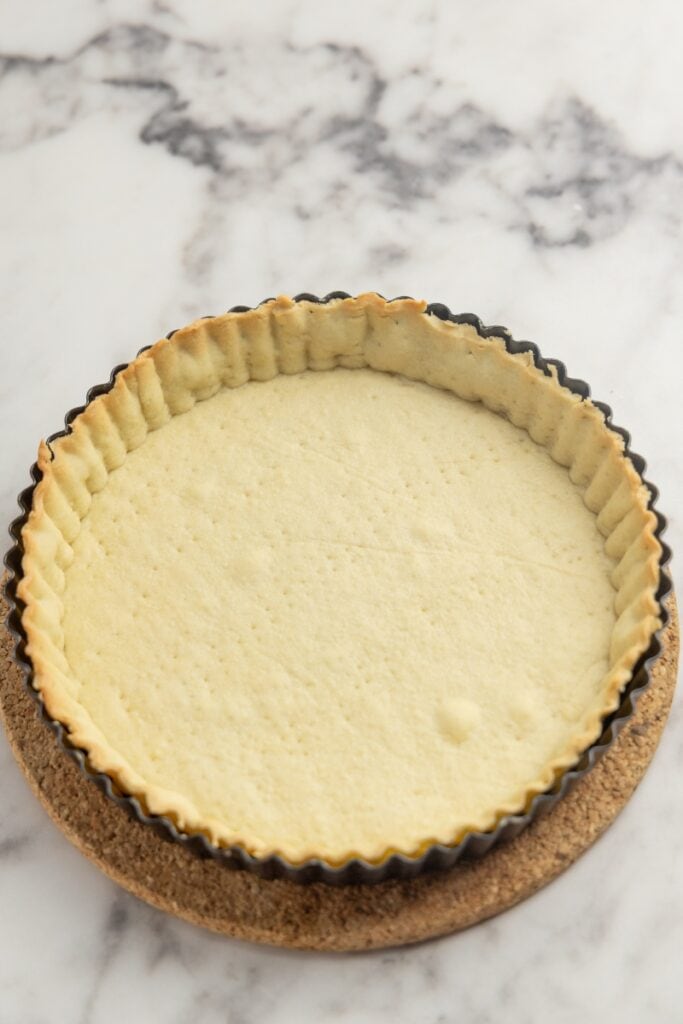
- Cool. Remove the pie dish from the oven and let it cool on the counter. After 10 to 20 minutes, remove the tart shell if the dish has a removable bottom.
How to Line a Tart Ring
Working with a tart ring is a bit more complex than with a pie dish, but it often yields slightly better results, like less shrinkage and more even sides.
- Butter tart ring. Rub a small knob of butter along the inside of the ring.

- Roll out. Roll the dough between two sheets of parchment to an even thickness of 1/8 inch, ensuring it’s large enough to cover the ring.



- Cut the base. Transfer the rolled dough to a perforated mat on a small baking tray. Cut the base by pressing the ring into the dough. Leave the ring in place, scrape away the excess dough, and return it between the parchment sheets to roll out the sides. Refrigerate the mat with the ring in place.



- Prep sides. Roll the remaining dough into a long rectangle, about 1/8 inch thick. Cut strips slightly wider than the ring’s height and as long as possible. Replace the parchment on top and freeze for 7 to 10 minutes until firm.
 Roll the excess dough, cut strips
Roll the excess dough, cut strips wider than the ring, and freeze
wider than the ring, and freeze
- Line sides. Remove the frozen strips and place them inside the tart ring, pressing them lightly against the ring. Overlap slightly at the seams and press to merge. Once the sides are lined, gently press down to merge with the base. Freeze the lined ring for 20 minutes. Work quickly while the dough is firm.
- Preheat oven. Preheat your oven to 360°F (180°C).
- Trim excess. Once chilled, remove the ring from the freezer and trim the excess dough. Place a knife inside the ring, pushing outward to ensure adhesion. Then, lightly press the sides against the ring one more time. A firm press is no good because you’ll press some of the dough into the tiny holes in the ring and will have a hard time removing the tart shell from the ring.


- Bake. Place the mat with the lined ring in the oven and immediately lower the temperature to 340°F (170°C). Bake for 13 to 16 minutes, until the shell is lightly browned. The color is more important than the baking time, so if you need a couple of extra minutes, that’s okay.
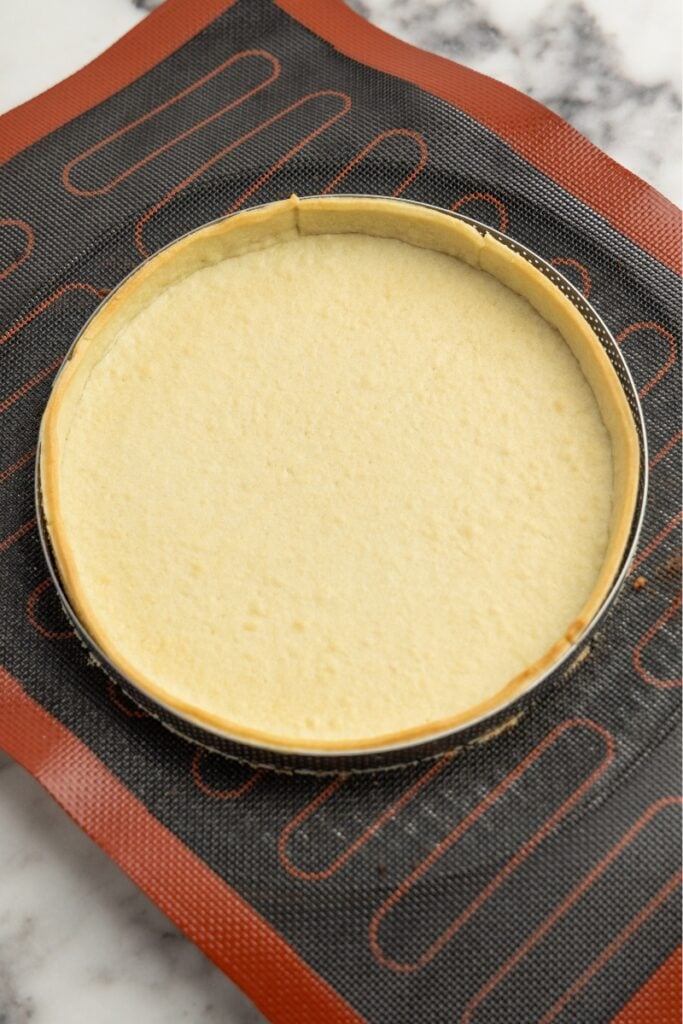
- Cool. Remove from the oven and let the tart shell cool on the counter. After 10 to 20 minutes, remove the shell from the ring.
Tips
- Use a silicone mat for rolling. Instead of using two pieces of parchment paper, you can use a silicone mat and one piece of parchment paper. Silicone mats tend to stick to the dough a bit more, so I prefer using parchment on top, then removing it after peeling away the silicone mat.

- Keep the dough chilled with a scraper or offset spatula. The dough is much easier to handle when it’s nice and cold. Instead of warming it up with your hands, use a scraper or offset spatula to move it around without softening it.
- Consider a rolling pin with rings. If you’re not confident about rolling to an even thickness, a rolling pin with silicone rings can help. This takes the guesswork out of it—I love mine.
- New to this? Make a bit more dough. If you’re still getting the hang of rolling out evenly and don’t have a rolling pin with thickness rings, make 10-20% more dough. This gives you some leeway if the dough ends up a bit thicker.
- Stuck shell? Be gentle. If the tart shell seems stuck in the ring, start by trimming any edges that visibly overlap. Then, turn the shell upside down and gently press around the bottom. Work slowly in a circle to find the spots that are stuck. Go slowly and be gentle—forcing it might break the shell.


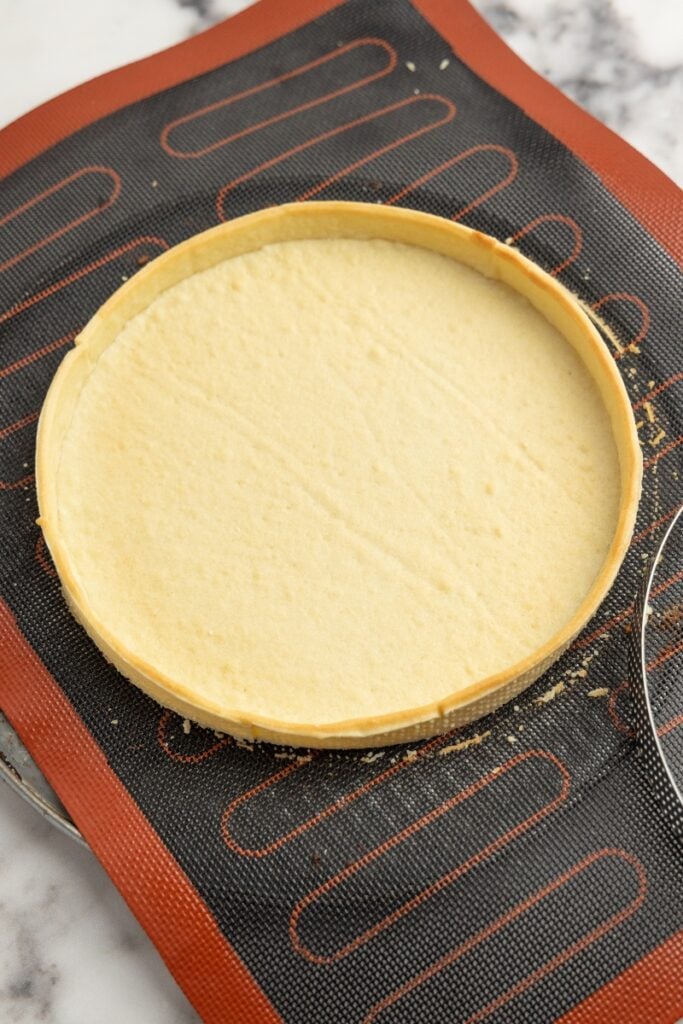
- Longer refrigeration is better. While the recipe calls for 2 hours of refrigeration before rolling, longer is even better. Prepping the dough the day before is a great option.
- Freeze if needed. If the dough starts tearing while you’re lining the tart ring or dish, it may be too warm. Pop it back in the freezer for 7-10 minutes to firm up before continuing.
- Make it prettier. You can gently rub a microplane or the bottom of a fine-mesh sieve over the sides and bottom of a baked tart shell to smooth out any irregularities.
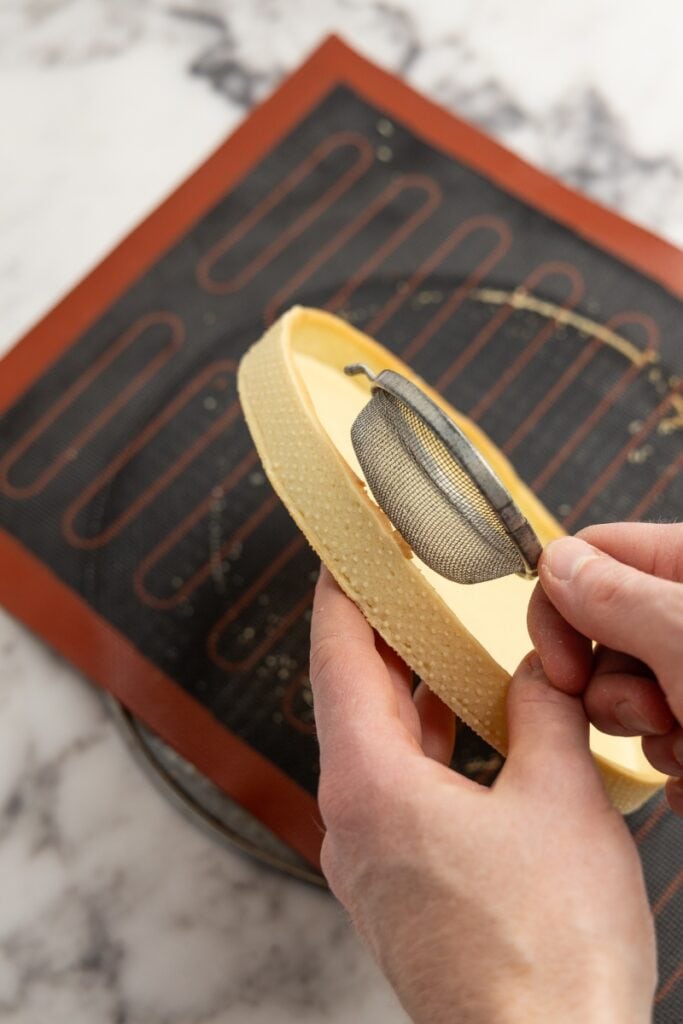
How to Use Extra Dough
After rolling out the dough and baking the tart shell, you’ll likely have some leftover dough. Instead of tossing it, turn it into a few cookies! Since pâte sucrée is already sweet and delicious on its own, all you need to do is roll it out and bake. Here’s how:
- Roll out the dough. Place the dough between two pieces of parchment paper and roll it out to about 1/8 inch thick.
- Cut cookies. Use a cookie cutter or knife to cut out shapes, but don’t remove them from the surrounding dough just yet.
- Freeze. Place the cut dough in the freezer for 10 minutes. This will make it easier to remove the cookies without tearing.
- Bake. On parchment paper or a perforated baking mat, bake the cookies in a preheated oven at 360°F (180°C) for 6 to 9 minutes, until they’re lightly browned.

Proportions by Pie Size
To get the perfect pâte sucrée shell no matter your dish, use these measurements based on the size of your pie dish:
| Ingredient | 6-inch Pan | 8-inch Pan | 9-inch Pan | 10-inch Pan |
|---|---|---|---|---|
| Butter | 22 g | 40 g | 50 g | 62 g |
| Sugar | 22 g | 40 g | 50 g | 62 g |
| Egg | 13 g | 24 g | 30 g | 37 g |
| Salt | Pinch | 1/8 tsp | 1/8 tsp | 1/8 tsp |
| Flour | 56 g | 99 g | 125 g | 154 g |
Storage
You can store pâte sucrée dough in the fridge for 3 to 4 days, covered tightly. Once you bake your tart shell, you can store it on the counter, covered, for about a week.

Equipment
- Parchment paper
- Pie dish
- Tart ring
Ingredients
- 50 g butter
- 50 g powdered sugar
- 30 g egg measured after cracking and whisking
- 1/8 tsp salt
- 125 g flour
Instructions
Make Pâte Sucrée:
- Cream Butter and Sugar. In a bowl, mix the butter and sugar until light and fluffy using a whisk or hand mixer. Ensure sugar is fully incorporated.50 g butter, 50 g powdered sugar
- Add Egg and Salt. Measure the exact amount of egg needed and add it with the salt. Mix to combine.30 g egg, 1/8 tsp salt
- Incorporate Flour. Add the flour and mix until the mixture resembles coarse crumbs. Bring the dough together with your hands into a cohesive mass without kneading.125 g flour
- Shape and Wrap Dough. Flatten the dough into a disc and wrap it in plastic wrap or place it in a resealable bag.
- Chill Dough. Refrigerate the dough for 2 hours to make it easier to roll out and to ensure a tender texture.
Lining a Pie Dish:
- Roll Out Dough. Roll the chilled dough between two pieces of parchment paper to an even thickness of 1/8 inch, large enough to cover the pie dish.
- Dock the Dough. Remove one parchment sheet and pierce the dough all over with a fork; this side will face down in the dish.
- Freeze Dough. Replace the parchment and freeze the dough for about 20 minutes until solid.
- Butter Pie Dish. Butter the base and sides of the pie dish.
- Transfer and Fit Dough. Remove the first parchment, place the dough over the pie dish with the pierced side down, remove second parchment, and gently press to fit the dish without stretching.
- Freeze Assembled Dish. Freeze the pie dish with dough for about 20 minutes.
- Preheat Oven. Preheat the oven to 360°F (180°C).
- Trim Excess Dough. After chilling, trim the excess dough, cutting outward to ensure adhesion to the pie dish.
- Bake Shell. Bake at 340°F (170°C) for 13 to 16 minutes until lightly browned. Tap any large bubbles (during baking) gently with a spoon.
- Cool Shell. Remove from oven and let cool. After 10 to 20 minutes, remove the tart shell if dish has a removeable bottom.
Lining a Tart Ring:
- Butter Tart Ring. Rub butter along the inside of the tart ring.
- Roll Out Dough. Roll the dough between parchment sheets to a thickness of 1/8 inch, large enough for the ring.
- Cut Base. Place the dough on a perforated mat on a baking tray, press the ring into the dough to cut the base, and remove excess dough. Refrigerate the mat with the ring.
- Prepare Sides. Roll remaining dough into a rectangle 1/8 inch thick, cut strips slightly wider than the ring's height, and freeze them until firm.
- Line Sides. Place frozen strips inside the tart ring, pressing lightly and overlapping seams. Merge sides with the base by pressing lightly and freeze for 20 minutes.
- Preheat Oven. Preheat the oven to 360°F (180°C).
- Trim Excess Dough. Remove from freezer and trim excess dough, pressing lightly against the ring.
- Bake Shell. Bake at 340°F (170°C) for 13 to 16 minutes until lightly browned.
- Cool and Remove Shell. Let the tart shell cool, then remove from the ring after 10 to 20 minutes.


